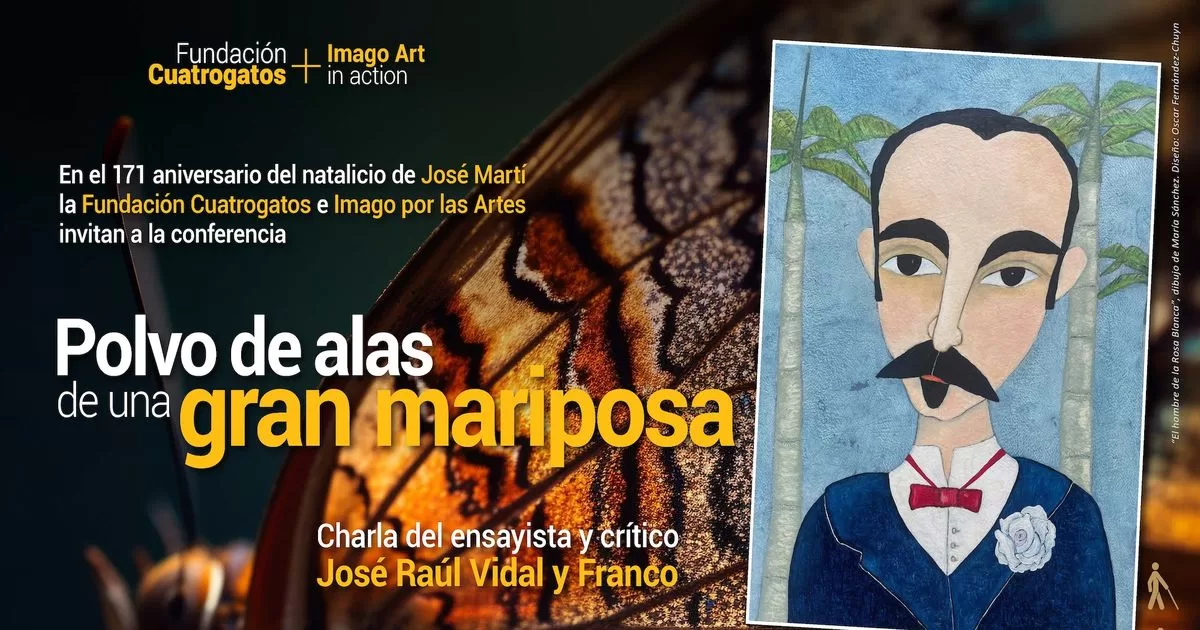MIAMI.- On Friday, January 26, 2024, at 8.30 pm, the Cuatrogatos Foundation and Imago por las Artes will celebrate the birth of the Cuban patriot and intellectual If Mart with a conference by the essayist and literary critic José Ral Vidal y Franco. The activity will take place at the Imago Art in Action headquarters (4028 SW 55 Avenue, South Miami, FL 33155). The talk will focus on the fourth collection of poems that Mart wrote, Powder from the wings of a large butterflywhich was left untouched when the Apostle died, facing the sun, on the battlefield fighting for the independence of Cuba.
Regarding this anniversary and the tribute to the most important figure in the history of Cuba, we interviewed Vidal y Franco, a student of the life and work of Martí to talk about the collection of poems about which to talk, a much less known book than the rest of those who make up Martí’s poetic production (Ismaelillo y free verses, both published in 1882, and Simple verses, in 1891.)
The fruit of the investigative work of Vidal and Franco are the books Jos Mart: by the fire of the bramble, Los Free Verses by José Martí: image notes y About Port-au-Prince. José Mart between weapons, bandits and traitors. He has also published essays and articles such as: Semantic rhythm as a structuring principle of Free Verses, Love is paid with love: an immense proverb, February 24, 1895, Disagreement: Mart, Gmez y Maceo, Fernando Poo, 1869: Final Destination and El Homagno by Jos Mart: some notes in the margin.
What can be said about the date and circumstances in which the verses that make up were written? Powder from the wings of a large butterfly?
The verses that make up Powder from the wings of a large butterfly They cover the entire decade of 1880 until probably 1892. So it is not a collection of poems of transition or youthful outburst, nor of simple references to possible future verses. The different way in which it rehearses the meter, the style, the intonation and the themes (especially, love, eroticism, women, beauty, verse) with respect to the three known collections of poems, places it as a legitimate and autonomous set within the context of Marti’s poetry. It is another approach to creative work, different and not transitional, of life and not of period, of office and not referential.
There is some thematic, compositional or stylistic link with the other three Marti poems (Ismaelillo, free verses y Simple verses)?
Powder from the wings of a large butterfly It is a collection of poems dedicated almost entirely to the theme of love (as far as eroticism and carnal relationships are concerned). The link with other collections of poems by the author is fundamentally due to the mystery of the concurrence of space and time, especially with free verses it is included Ismaelilloon which he worked simultaneously during the 1880s. There are other themes, although of lesser presence, such as exile, the big city and perhaps the absence of the wife, which do not become distinctive themes of the collection of poems.
What characteristics distinguish this book from the rest of José Martí’s poetic production?
It is a collection of poems dedicated to the mystery of love as a shared and, at the same time, forbidden feeling. We do not know who inspired these verses, but I do know that the mysterious and unnameable lady is the cause of the distress that leaves the uninhabited alma of the poet. But Mart does not speak in them of any distress, but on the condition of living two or several solitudes in one.
In terms of style and meter, Powder from the wings of a large butterfly It is an experimental symphonic catalog that runs between pavanes, madrigals and epigrams, whose formal, functional and semantic characterization according to these strophic types marks the difference with the rest of the Martian collections that we know so far.
What does it contribute to Martí’s poetic work? Powder from the wings of a large butterfly?
It is Martí’s last collection of poems on which he is known to have been working for more than a decade. Perhaps it is the one that best covers the most turbulent journeys of the intimate and public life of the poet who says: For poetry: / Armona is not artifice. In fact, there is a whole aura of mystery around these verses that to this day we do not know who inspired them. Woman, passion and verse give the key to the loving note of this poetic group.
How do we find out about the existence of this work and when was it published for the first time?
It is not until the publication of the Mart’s Complete Workswith the Trpico publishing label (between 1936 and 1949), which Gonzalo de Quesada y Miranda, son of Gonzalo Quesada y Arstegui, brought to light a series of poems under the title Butterfly wings powdercompiled from a list of verses sketched by Mart in the margin of which the phrase appears in his own handwriting These verses are dust from the wings of a great butterfly. The compiler thought it appropriate to paraphrase the same idea to title the new group of verses as Butterfly wings powderto which he adds a second bunch of poems Pain as a guardianalso named by himself from the first verse of the poem that begins this second new series that, due to its form, tone and style, resembles the first group.
Which edition would you recommend to readers and why?
I recommend the edition made by Emilio de Armas, If Mart. Powder from the wings of a large butterflypublished under the Emmanuel publishing imprint, Coleccion Entre Ríos, 2018. This edition is based on the transcription of the original manuscripts on which Emilio de Armas worked as part of the editorial team of the Critical Edition of the Complete Poem by José Martí, in 1981. This is an edition faithful to the one outlined by Martí.
What new research projects or books are you currently working on? Does anyone have anything to do with Jos Mart?
Precisely at this moment I am working on a book whose provisional title is Dust from the Wings of a Great Butterfly: the last collection of poems by José Martí. It’s already assembled, I just need the closure. Always, of course, new ideas or data appear that I incorporate immediately. I started writing it from notes and notes that I made around twenty years ago. Maybe it will go off the presses in June.
In addition, I dedicate part of my time to collecting some essays on historical topics such as the October 10 uprising, which marks the beginning of the first war for Cuban independence; the deportations of Cubans to the island of Fernando Poo in the 19th century, the La Mejorana meeting, in 1895, attended by Antonio Maceo, Mximo Gómez and José Martí to align the plans and course of the second independence feat.
I am also considering publishing the correspondence I had with Father Carlos Manuel de Céspedes, great-great-grandson of Carlos Manuel de Céspedes y del Castillo, first president of the Republic of Cuba in Arms, and with Carlos Ripoll, a Cuban historian who dedicated his life to the study of Martian work.




